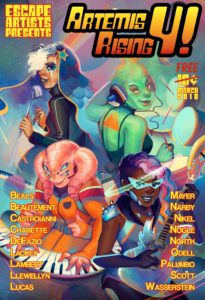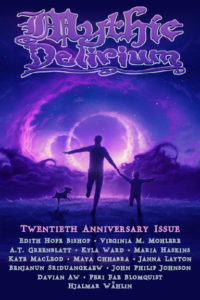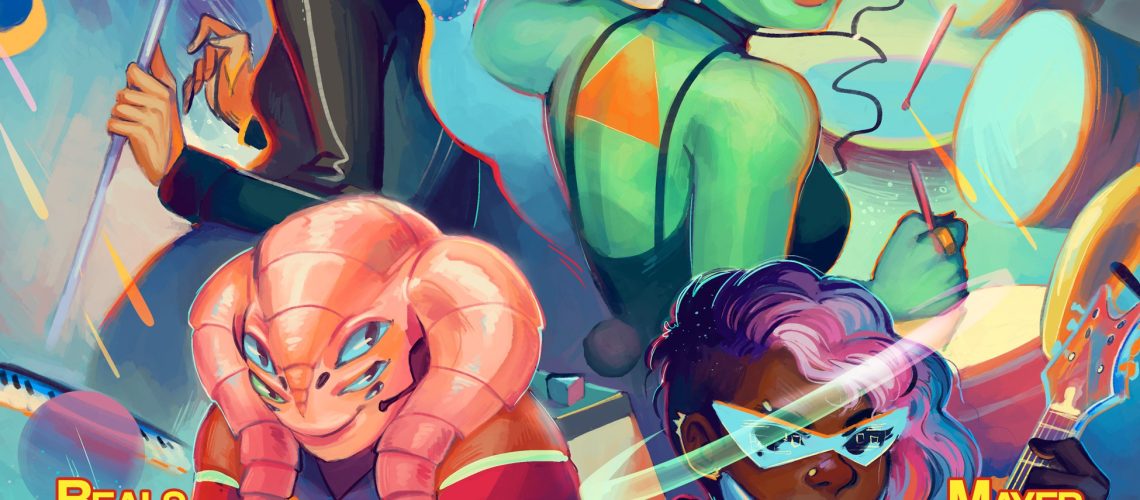My favorite stories this month were either relationship dramas or haunted house stories, broadly construed. For a story about a trans witch falling in love, check out “Graveyard Girls on Paper Phoenix Wings” by Andrea Tang, which appears in Glittership Episode 51 (March 5, 2018). It’s a story with marvelous worldbuilding and really cute and likable characters. In “Assistance” by Kathryn DeFazio, which appears in Escape Pod Episode 621 (March 29, 2018), a nonbinary person with anxiety is emotionally supported by an assistive android. It’s a simple and mundane story that’s also incredibly gentle and moving. “All Profound and Logical Minds” by Bennett North, which appears in Escape Pod Episode 618 (March 8, 2018), is a relationship drama between two sisters that’s also a haunted space station adventure. It’s fun, gripping, and inventive. Finally, I was seriously spooked by “Red as Water, White as Ruin” by Benjanun Sriduangkaew, which appears in Mythic Delirium 4.4 (April—June 2018). In this story, a shipful of exiles and outcasts investigate a planet that has suffered an inexplicable apocalypse.

I want to note that both “Assistance” and “All Profound and Logical Minds” are part of Artemis Rising 4, an “annual month-long event across all four Escape Artists podcasts, celebrating the voices of women, non-binary, trans, and marginalized gendered authors in genre fiction.” I also want to note that “Red as Water, White as Ruin” appears in what is (at least for now) the last issue of Mythic Delirum, as Mike Allan has announced that he’ll be putting the zine on an indefinite hiatus. The zine ends on a high mark, a twentieth anniversary special issue which I rather enjoyed, so if you enjoy “Red as Water, White as Ruin,” I’d recommend you check out the rest of the issue. Now, on to the reviews!
“Graveyard Girls on Paper Phoenix Wings” by Andrea Tang
In this story, Magdalisa is the caretaker of the Dalaga Cemetery for Misguided Ladies, a place where the ghosts of immoral women are sent to repent. (In actuality, they’re women who didn’t fit into repressive social structures, and the ghosts spend most of their time simply gossiping.) Rigo, a flyboy riding a paper phoenix, is struck down by the city sentries and crash lands in Dalaga Cemetery. After Magdalisa saves his life, a romance develops between the two of them, and Magdalisa is brought to reevaluate her reasons for staying at the cemetery. The main narrative is intercut with flashbacks to Magdalisa’s past, each scene exploring Magdalisa’s different reasons for coming to Dalaga Cemetery.
Magdalisa and Rigo’s relationship is lovely. Their romance is cute, intelligent, and respectful. My favorite bit was Rigo’s nonchalant acceptance when Magdalisa outed herself as trans. My second favorite bit was when Rigo and Magdalisa got into a theological debate. God, I wish relationships like this were more common.
The worldbuilding is robust and first-rate. Tang portrays a fleshed-out world in which religion plays a key role in social-political life. Within the universe of the story, the local religion is aligned with a strict, repressive social order. The High Priest of the sun god Dal seems to be one of the major political figures, and I got the sense that structures of exclusion and marginalization are integral to the social order. What makes this story work so well is that Tang crafts a vivid world with an oppressive social order and then allows the narrative to align itself with the marginalized persons in society, the misanthropes and the outcasts. Magdalisa is a trans witch who isn’t accepted by the Witches Corps or her own family. Rigo is a wanderer who is nearly murdered by the city sentries. And the ghosts of the Dalaga Cemetery are well aware of the paternalism that founded their cemetery. I wish I could read a longer work set in this world to see the worldbuilding developed in more detail. I also wish I could see what the future has in store for Magdalisa and Rigo.
The story does get heavy. I need to include a trigger warning for a transphobic society. However, although Magdalisa isn’t truly accepted by society or her family, she is accepted and loved by her Tita Shulin and Rigo. Ultimately, this story is about a trans girl finding herself, finding acceptance and love, and finding her people. It’s awesome.
“Assistance” by Kathryn DeFazio
Astor has anxiety, and ever since witnessing a traumatic event last year, Astor’s anxiety has been much worse. Last week, Astor could hardly handle going to the grocery store. Fortunately, Astor has PAGE, an assistive android that helps Astor manage their anxiety. PAGE feels like a mix between Astor’s friend and their therapist, kindly asking Astor if they would like to discuss their coping plan and, when Astor recalls their trauma, PAGE reminds Astor that “There was nothing you could do […] You are not responsible for what happened.” This is a small and mundane story—mostly, it’s just about Astor preparing to leave town for a funeral. However, the relationship between Astor and PAGE is so caring and tender that I have to say this is one of the most moving stories I’ve read this year. I honestly feel like a kinder person for having read this.
I’m fascinated by how this story is simultaneously moving yet mundane. I think DeFazio manages this in part because of how she plays with disability. I’m reminded of Susan Wendell’s essay “The Social Construction of Disability.” In that essay, Wendell argues that society is designed to accommodate young, able-bodied men and that when the pace of life increases in a society, more people become “disabled” even though there may be no changes to their physical abilities. According to the social model of disability, disabilities are created when society fails to include people, rather than equating disabilities with physical or psychological aptitudes. At the core of the story, “Assistance” is about someone who, thanks to assistive technology and social policy, is able to leave town for their cousin’s funeral, something they might not have been able to do otherwise. It’s important to note that Astor gets PAGE through the government, not because Astor purchased PAGE on their own (they couldn’t afford to). It’s an example of how disability can be socially constructed—how the combination of infrastructure, technology, and social policy can either enable people or exclude them from fully participating in public (and even private) life. “Assistance” makes me want to read more similarly mundane stories that construct (dis)ability in more inclusive ways.
“All Profound and Logical Minds” by Bennett North
In this story, two sisters attempt to fix a rogue space station AI by performing an atheist exorcism. North writes, “Rogue AIs, having been designed by humans, were inevitably rooted in human culture, and some pattern of vocal cadence and body language worked to untangle the corrupted code. It didn’t matter what you said, just how you said it. You needed unshakeable belief in something, and confidence that what you were doing was going to succeed.” Catholic exorcisms are the par excellence of such rituals, provided that you’re Catholic and believe you can exorcise a space station. Hannah and Bethany aren’t and don’t, so they’ve developed their own “science exorcism” that works to repair rogue AIs. Sure, it’s a silly idea, but North’s prose and worldbuilding made it seem just plausible enough, and it made for a unique plot mechanic that I really enjoyed, an intriguing new twist on a classic adventure/survival story.
I was so wrapped up in the adventure story that I didn’t realize until the end I was also reading a perfectly plotted relationship drama. When Hannah and Bethany were younger, they barely survived their own space station going rogue, and now Hannah, the older sister, is overprotective and domineering while Bethany resents Hannah’s lack of trust in her. Safely debugging a rogue space station, however, is a dangerous task, and the situation demands that Hannah and Bethany trust each other and work smoothly together. By the end of the story, I was invested in both Hannah and Bethany’s rocky relationship and their situational peril, and I found the climax to be both gripping and a lot of fun. I didn’t realize this at first, but the beats for both plot-lines (the adventure story and the relationship drama) fall at pretty much the same moments, which makes for a really engaging read.

“Red as Water, White as Ruin” by Benjanun Sriduangkaew
After a planet has suffered an inexplicable apocalypse, a shipful of exiles, outcasts, and criminals is sent to investigate. If they bring back something valuable, they’ll receive amnesty. If they don’t, they’ll receive their punishments, ranging from death to banishment. Their spaceship is programmed to only fly between “the Breach” and their homeworld, and the exiles can’t override it. The exiles can’t find any clues to what happened, but they do find one survivor, a child named Ouma who doesn’t speak much.
This is one of my favorite horror stories I’ve come across. It’s a haunted house story where the “house” is actually a deserted, foreboding planet. The prose is sparse when describing the characters and their actions but almost florid when describing the haunting world, which creates the atmosphere of a grim fable. It almost feels like a dark fairy tale, or perhaps a campfire tale that travelers of another civilization share with each other in shadowy space station taverns. The ending of this story is the best part—it’s disturbing, surprising, and haunting. After reading this story, I have a new nightmare about what might be waiting for us out in the stars.







